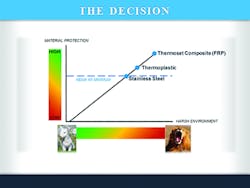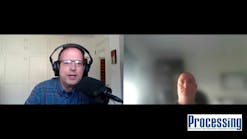The goal of a control installer is to make sure every installed product meets inspection requirements. There is nothing more frustrating than when an inspector and/or certifier does not approve your electrical product or installation.
Standards, or ratings, of enclosures are not meant to make it more difficult for final products or control installation to be approved by inspectors. They ensure the product is safe and will perform as promised in the environment it has been placed in. These standards and ratings, are important not only to industrial facilities, but also to municipalities that can avoid costly lawsuits by adopting a single, standard set of building code laws.
The National Electrical Code (NEC) is the adoptable standard used for guiding safe installation of electrical equipment in the United States. Keep in mind, some of the NEC codes have been altered by local governing bodies, so it is always best to investigate local codes before beginning any project.
NEC also maintains the requirement of "listed" or "labeled" electrical equipment. To be listed, a piece of equipment must meet the testing requirements set by a listing agency, such as Underwriters Laboratories (UL), Intertek (ETL) or CSA Group. These listing agencies also inspect a manufacturer’s facilities and processes to ensure that products will be produced repeatedly with the same high-quality standards year over year.
In addition to NEC standards, the National Electrical Manufacturers Association (NEMA) develops, modifies and publishes the standards for electrical apparatuses that include enclosures typically used in industrial applications.
Unlike UL, NEMA does not test products. It has standard performance criteria for enclosures in different environmental conditions, not criteria for how they are manufactured. The following are NEMA standards to use as a good starting place for your enclosure selection. If you have any questions about the standards for your application, it is best to contact the distributor or manufacturer for answers.
How materials relate to NEMA 4X compliance through corrosion resistance. Courtesy of Stahlin
Summary of NEMA 250-2018 enclosure types for non-hazardous environments
The following discussion provides definitions from the NEMA 250-2018 Enclosures for Electrical Equipment standard for use in non-hazardous locations. This standard covers enclosures for electrical equipment rated not more than 1,000 volts (V). Listed below, are specific enclosure types, their applications and the environmental conditions they protect against when they are completely and properly installed as outlined by NEMA. (For full details on these NEMA ratings, visit nema.org.)
Type 1: Enclosures constructed for indoor use to provide a degree of protection to personnel against access to hazardous parts and to provide a degree of protection of the equipment inside the enclosure against ingress of solid foreign objects (falling dirt).
Type 2: Enclosures constructed for indoor use to provide a degree of protection to personnel against access to hazardous parts; to provide a degree of protection of the equipment inside the enclosure against ingress of solid foreign objects (falling dirt); and to provide a degree of protection with respect to harmful effects on the equipment due to the ingress of water (dripping and light splashing).
Type 3: Enclosures constructed for either indoor or outdoor use to provide a degree of protection to personnel against access to hazardous parts; to provide a degree of protection of the equipment inside the enclosure against ingress of solid foreign objects (falling dirt and windblown dust); to provide a degree of protection with respect to harmful effects on the equipment due to the ingress of water (rain, sleet, snow); and that will be undamaged by the external formation of ice on the enclosure.
Type 4: Enclosures constructed for either indoor or outdoor use to provide a degree of protection to personnel against access to hazardous parts; to provide a degree of protection of the equipment inside the enclosure against ingress of solid foreign objects (falling dirt and windblown dust); to provide a degree of protection with respect to harmful effects on the equipment due to the ingress of water (rain, sleet, snow, splashing water, and hose directed water); and that will be undamaged by the external formation of ice on the enclosure.
Type 4X: Enclosures constructed for either indoor or outdoor use to provide a degree of protection to personnel against access to hazardous parts; to provide a degree of protection of the equipment inside the enclosure against ingress of solid foreign objects (windblown dust); to provide a degree of protection with respect to harmful effects on the equipment due to the ingress of water (rain, sleet, snow, splashing water and hose directed water); that provides an additional level of protection against corrosion; and that will be undamaged by the external formation of ice on the enclosure.
Type 5: Enclosures constructed for indoor use to provide a degree of protection to personnel against access to hazardous parts; to provide a degree of protection of the equipment inside the enclosure against ingress of solid foreign objects (falling dirt and settling airborne dust, lint, fibers, and flyings); and to provide a degree of protection with respect to harmful effects on the equipment due to the ingress of water (dripping and light splashing).
Type 6: Enclosures constructed for either indoor or outdoor use to provide a degree of protection to personnel against access to hazardous parts; to provide a degree of protection of the equipment inside the enclosure against ingress of solid foreign objects (falling dirt); to provide a degree of protection with respect to harmful effects on the equipment due to the ingress of water (hose directed water and the entry of water during occasional temporary submersion at a limited depth); and that will be undamaged by the external formation of ice on the enclosure.
Type 6P: Enclosures constructed for either indoor or outdoor use to provide a degree of protection to personnel against access to hazardous parts; to provide a degree of protection of the equipment inside the enclosure against ingress of solid foreign objects (falling dirt); to provide a degree of protection with respect to harmful effects on the equipment due to the ingress of water (hose-directed water and the entry of water during prolonged submersion at a limited depth); that provides an additional level of protection against corrosion and that will be undamaged by the external formation of ice on the enclosure.
Type 12: Enclosures constructed (without knockouts) for indoor use to provide a degree of protection to personnel against access to hazardous parts; to provide a degree of protection of the equipment inside the enclosure against ingress of solid foreign objects (falling dirt and circulating dust, lint, fibers, and flyings); and to provide a degree of protection with respect to harmful effects on the equipment due to the ingress of water (dripping and light splashing).
Type 13: Enclosures constructed for indoor use to provide a degree of protection to personnel against access to hazardous parts; to provide a degree of protection of the equipment inside the enclosure against ingress of solid foreign objects (falling dirt and circulating dust, lint, fibers, and flyings); to provide a degree of protection with respect to harmful effects on the equipment due to the ingress of water (dripping and light splashing); and to provide a degree of protection against the spraying, splashing, and see page of oil and non-corrosive coolants.
Impact, ingress and fire protection
In addition to these most recognized standards from NEMA, there are several others that help enclosure specifiers choose the best option for the application. Ratings that demonstrate the degree of impact protection (IK), IEC 62262, and ingress protection (IP), IEC 60529, are critical for international acceptance.
IK ratings
How do you specify an enclosure that stands up to impact? Look for the internationally recognized IK10 rating. IK ratings are defined as IKXX, where "XX" is a number from 00 to 10, indicating the degree of protection provided by electrical enclosures against external mechanical impact. The higher the number, the more protection provided with an IK10 being the highest rating available.
The ability of an enclosure to resist impact energy levels is measured in joules (J).
IP ratings
The International Electrotechnical Commission (IEC) International Protection Marking, also referred to as Ingress Protection Rating (IP rating), classifies the degrees of protection against both solids and liquids in electrical enclosures. These rating are based on a proven ability to withstand intrusion by something as small and gentle as a particle of dust and as large and strong as water "projected in powerful jets" as stated in the IEC standard.
As OEMs expand into the international marketplace there has been a growing demand for enclosures that carry both NEMA standards for North America and IEC standards for international acceptance.
IEC provides the International Standards and Conformity Assessment for all electrical, electronic and related technologies. The IP ratings begin with IP, for ingress protection or the act of entering, followed by two numerical digits. The first digit describes the rating that is given for solid objects such as dust. The second digit defines how well the enclosure can keep liquids (water) out. The lower the number, the lower the protection level.
Source: Standard EN 62262
Fire rating
Another important rating is UL 2043, the UL Standard for Safety Fire Test for Heat and Visible Smoke Release for Discrete Products and Their Accessories Installed in Air-Handling Spaces. UL 2043 is for space-compliant applications that include meeting three requirements:
- The peak rate of heat release measured during each enclosure tested is 100 kilowatts (kW), or less.
- The peak smoke release rate measured during each test is 0.21 m²/s, or less.
- The total smoke released (10-minute test duration) is 75 m², or less.
The UL test determines the rate of heat release and the rate of smoke release of the burning product samples as they relate to the requirements for fire resistance and low-smoke producing characteristics in accordance with the provisions of the following codes: National Electric Code, NFPA 70; International Mechanical Code, NFPA 5000; and Standard for the Installation of Air Conditioning and Ventilating Systems, NFPA 90A.
Some enclosure manufacturers offer non-metallic enclosures specially designed to be compliant with all industry standards for hose-down water-tightness and corrosion resistance. This includes: UL, cULus and CSA listed for NEMA 250 Type 1, 3, 3R, 4, 4X, 6, 6P, 12, 13; IEC 60529 IP66, IP67, IP68; temperature ranges from -76°F to 274°F (-60°C to 134°C); flammability rating UL94-5V, self-extinguishing, non-halogenated, non-flame propagating; and NFPA No. 101 flame spread class A (1).
Manufacturer Stahlin Non-Metallic Enclosures offers patented material formulation on their non-metallic type enclosures, which allows them to stand up to these many requirements. The compound ensures every enclosure manufactured is rugged and durable in environments where exposure to harsh environments is imminent. These enclosures are selected by companies that require secure protection and need to meet the necessary requirements set for non-metallic enclosures by NEMA and IK standards.
Roger Schroder is currently Stahlin Non-Metallic Enclosures Product Manager and an experienced engineering manager with a demonstrated history of working in the automotive and electrical and electronic manufacturing industry. He is skilled in engineering management, cross-functional team leadership, advanced product quality planning (APQP), injection molding of thermoplastic materials and compression molding of thermoset polymers. Schroder earned his MBA from Indiana Wesleyan University and his Bachelor of Science in mechanical engineering technology from Lake Superior State University.





